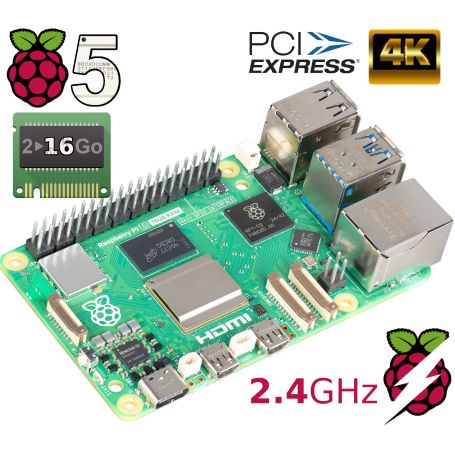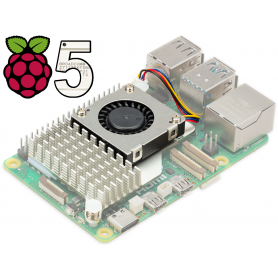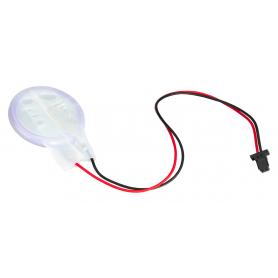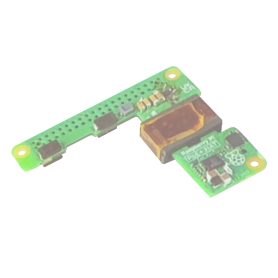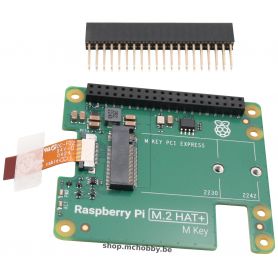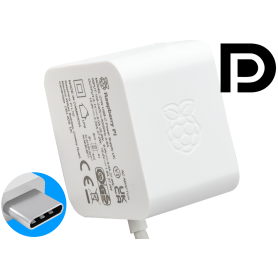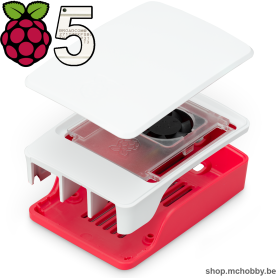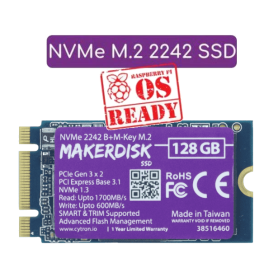Raspberry-Pi 5 - Nano-ordinateur monocarte surpuissant
Raspberry-Pi 5 Nano computer with 4 cores CPU 4 at 2.4 GHz (ARMv8) fitted with 2 to 16Go RAM, two 4K HDMI output, one PCI express 2.0 bus as well as an RTC clock. Wireless support with WiFi 2.4 & 5 Ghz & Bluetooth 5.0. Ethernet Gigabit network interface (900 mb/s) ready for Power Over Ethernet (PoE). 2 MIPI ports to connect cameras or graphical display. Connectivity: USB: 2x USB 2.0 + 2x USB 3.0 at 5 Gbps, Fan with speed control, UART debug port.
Payments are secured by LyraCollect, a French payment collection company.
It is possible to delivered to your home, to a pick-up point or picked up by appointment at MCHobby
We prepare, pack and ship your orders with great respect and care.
Raspberry-Pi 5 - the second revolution in the nano computer area
The Raspberry-Pi 4 offered us exemplary stability thanks to its internal PCI bus. His rise to power was breathtaking. Could the foundation do better?
The Raspberry-Pi 5 has gone into Godzilla mode. You will discover, here below, that it shake up all our preconceived ideas.
Thee Raspberry-Pi 5 do exists in multiple versions : 2, 4, 8, 16 Go of RAM.
What's up doc?
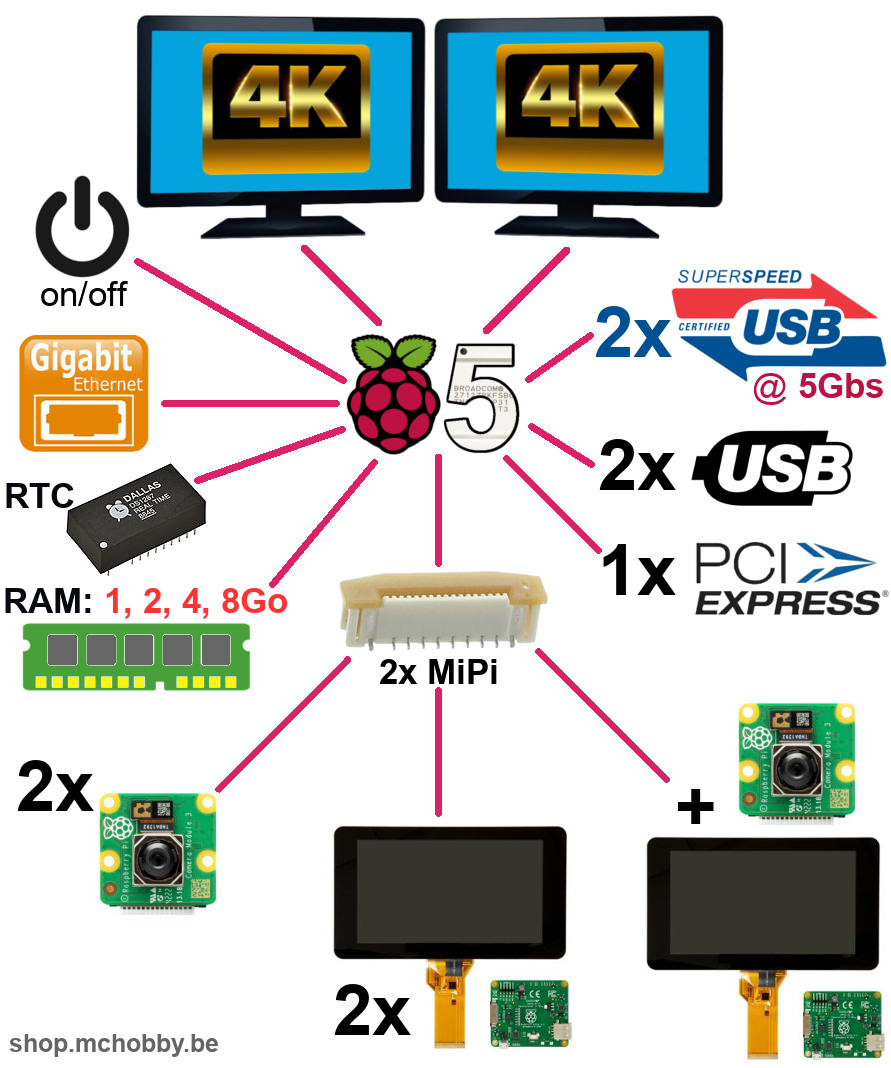
The Raspberry-Pi 5 is a jewel of technology:
- it is now fitted with the RP1 chip, a southbridge (similar to compuiter) unloading processor from bus management and low level devices handling.
- A new Broadcom 2712 SoC which is a 2 to 3 more powerful processor now clocked at 2.4Ghz (instead of 1.5 GHz).
- An USB 3 transfer rate of 5 Gb/s (even simultaneous over the two USB 3 connector)!
- Up tp 1.6Amp over the USB port (with a USB PD power supply. PD = Power Delivery)
- 4K60p with a desktop spawn over 2 monitors ans still offering smooth 4K!
- 2x MiPi port = 2 port with CSI/Camera or 2 ports with DSI/display or 1 CSI + 1 DSI
- Gigabit Ethernet still as efficient.
- A PCI Express 2.0 user port for using high speed device (M.2 SSD, signal acquisition, etc)
- A port UART autonomous and separated from GPIO.
- A RTC Clock with connector for the rechargeable battery.
- the microSD now support the SDR104 mode raising the data rate to 20 Mo/s (tested with sequential writing up tp 32 Mo/sec on our Kingston microSD).
- Raspberry Pi OS "bookworm" received so many optimisation (see the "tutorial" section)
What else...

Smooth 4K 60p... improvement of 4K rendering which now allows to have a desktop that extends over a dual 4K screen (and 4K video). Having tested it during the 2023 Partner Event organized by the Foundation, I can say that the configuration keeps its promises with a reasonable processor load. I also had the opportunity to display a 4K video on one monitor while using the desktop still available on the second 4K monitor... passing a window above the film puts a strain on the processor (90%) but again, no LAG.
Looking forward to the MediaPlayer upgrade to the Pi 5 :-)
 Up to 8Go RAM! The Raspberry-Pi 5 is available in several versions! But why different RAM sizes? well for reasons of price and application! An audio system will not need more than 1GB, as well as embeeded applications. 4K applications will rather go towards the 2 and 4GB models, in fact the VideoCore can be configured to use between 0 and 4GB of RAM. The 2GB model may also be suitable for more resource-demanding applications (e.g. Jeedom and its MySQL engine). The 4GB and 8GB models will be recommended for web browsing (very memory intensive) and resource-intensive applications (4K, office, PC type).
Up to 8Go RAM! The Raspberry-Pi 5 is available in several versions! But why different RAM sizes? well for reasons of price and application! An audio system will not need more than 1GB, as well as embeeded applications. 4K applications will rather go towards the 2 and 4GB models, in fact the VideoCore can be configured to use between 0 and 4GB of RAM. The 2GB model may also be suitable for more resource-demanding applications (e.g. Jeedom and its MySQL engine). The 4GB and 8GB models will be recommended for web browsing (very memory intensive) and resource-intensive applications (4K, office, PC type).
LPPDR4x RAM: remains identical to that of the Pi 4 and uses a 2.4Ghz bus (the Pi 3 used a 900 MHz bus). Bandwidth to memory remains crucial for good performance!
 USB 3.0 Super Speed : still present on the Pi 5, the USB 3 ports now benefit from the new RP1 southbridge allowing 5 Gbs to be supported simultaneously on the two USB 3 ports. The Via chip was a surprise on the Pi 4, the RP1 southbridge further improves general performance. The USB 3 ports was also tested with HDParm from 324 MB/S to 2028 MB/s with an SSD AND from 108 MB/s to 2004 MB/s with a mechanical hard drive. It is of course possible to boot over the USB 3.0.
USB 3.0 Super Speed : still present on the Pi 5, the USB 3 ports now benefit from the new RP1 southbridge allowing 5 Gbs to be supported simultaneously on the two USB 3 ports. The Via chip was a surprise on the Pi 4, the RP1 southbridge further improves general performance. The USB 3 ports was also tested with HDParm from 324 MB/S to 2028 MB/s with an SSD AND from 108 MB/s to 2004 MB/s with a mechanical hard drive. It is of course possible to boot over the USB 3.0.
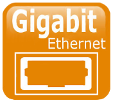 Ethernet Gigabit : always present, the Gigabit Ethernet controller also passes data through the southbridge. The network transfer is, of course, up to par with its predecessor tested at 900 Mb/s.
Ethernet Gigabit : always present, the Gigabit Ethernet controller also passes data through the southbridge. The network transfer is, of course, up to par with its predecessor tested at 900 Mb/s.
Boardcom 2712 @ 2.4 Ghz processor : still with 4 cores, the BCM2712 is built with Cortex-A76 which are twice as efficient as its predecessors at the same frequency. Boosted to 2.4 GHz, the processor also has “crazy” bandwidth with its southbridge.The new generation of VideoCore (version VII) is also more efficient and capable of handling 1 GigaPixels/sec. Assuming that the Pi 4 was already a "monster of power", you will understand why I do compare the Pi 5 to Godzilla (in term of power) .
 The PCIe 2.0 bus: is one of the big surprises of the Raspberry-Pi 5. Accessible via an FPC 16 connector, it will allow high-speed peripherals to be connected to the Raspberry-Pi 5. The future will see the appearance of many PCI devices for Raspberry-Pi.
The PCIe 2.0 bus: is one of the big surprises of the Raspberry-Pi 5. Accessible via an FPC 16 connector, it will allow high-speed peripherals to be connected to the Raspberry-Pi 5. The future will see the appearance of many PCI devices for Raspberry-Pi.
There is no doubt that the first application will be an interface for M.2 disk which will offer instant loading of the OS. At the foundation's Partner Event 2023, we received confirmation that the Raspberry-Pi OS team will support/include as many PCIe drivers as possible. The future of PCIe connector looks bright. The bandwidth offered by PCI Express also makes it possible to accommodate several devices via an aggregator.
The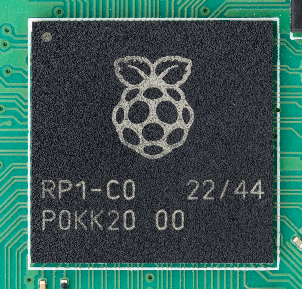 RP1 southbridge : is the new arrival on the Raspberry-Pi 5 and as you can see, it is stamped with a Raspberry logo. This is a component created by the foundation to meet its own needs. This component is comparable to the southbridge of computers in the sense that it offloads the processor by taking care of communication with the various peripherals. This component has a “crazy” bandwidth with the processor, which makes it possible to maintain very high speeds with all the peripherals it manages. The southbridge supports 2 PCI endpoints, Gigabit Ethernet, 2x USB3.0 controller, 2x SDIO (not used), MiPi transceiver (camera/display), 3 video DACs (PAL and NTSC) of which only composite is used, Delta Sigma Audio PWM. RP1 also manage the bandwidth devices like GPIO, I2C, SPI, PWM, UART, I2S.
RP1 southbridge : is the new arrival on the Raspberry-Pi 5 and as you can see, it is stamped with a Raspberry logo. This is a component created by the foundation to meet its own needs. This component is comparable to the southbridge of computers in the sense that it offloads the processor by taking care of communication with the various peripherals. This component has a “crazy” bandwidth with the processor, which makes it possible to maintain very high speeds with all the peripherals it manages. The southbridge supports 2 PCI endpoints, Gigabit Ethernet, 2x USB3.0 controller, 2x SDIO (not used), MiPi transceiver (camera/display), 3 video DACs (PAL and NTSC) of which only composite is used, Delta Sigma Audio PWM. RP1 also manage the bandwidth devices like GPIO, I2C, SPI, PWM, UART, I2S.
So many information... and we still have things to say about the Raspberry-Pi 4. See the "Tutorial" section for more informations.
What's identical
- USB-C for powering: now compatible with PD PSU (Power Delivery). The foundation recommend the usage of the USB-C PD 27W PSU for a best experience with the Pi 5.
- micro HDMI: still identical for those used with the Raspberry-Pi 4.
- GPIO Raspberry-Pi: retro-compatible with the Pi 4, Pi 3, etc.
- USB 3: still at the same place.
- microSD card: still at the same place.
What's changed
- New form factor: almost identical. New case available (well thinked case).
- USB2 and Ethernet swapped: this is the raison of the new form-factor.
- PoE conn. moved: so a new PoE module.
- Jack removed: analog output video output. Audio PWM output removed.
- New MiPi ports: placed at the old camera port. A specific ribon cable for the Pi 5 set the MiPi port as Camera function (CSI ribbon) or Display function (DSI function).
- UART port added: separated from RPi GPIO
- Lipo conn. added: to keeps RTC running.
- On/Off button added: Press once to show shutdown option, press twice for instant shutdown.
- PCIe conn. added: available as 16 lines FPC connector.
- Fan conn. added: able to detect and activates the fan. Variable speed control.
- New fixation hole: to secure the passive cooler.
Tutorials
- Discovering Raspberry-Pi 5 (Blog MCHobby, French)
Many details about the new Pi 5 - Video on Raspberry-Pi 5 (Geff Geerling, English)
With lot of test and tuning
- Raspberry Compatibility
- Pi 5
- CPU RAM
- 16 Go, 8 GB, 4 GB, 2 GB
- CPU Frequency
- 2.4 GHz
- WiFi
- Iinternal ant.
- Ethernet
- Gigabit
- Bluetooth
- BLE 5.0

